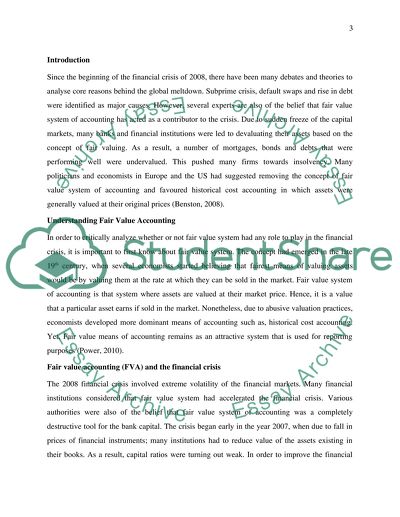Cite this document
(“The recent financial crisis has led to a strong debate about the Assignment - 1”, n.d.)
The recent financial crisis has led to a strong debate about the Assignment - 1. Retrieved from https://studentshare.org/finance-accounting/1637100-the-recent-financial-crisis-has-led-to-a-strong-debate-about-the-advantages-and-disadvantages-of-fair-value-accounting-in-particular-many-critics-have-argued-that-fair-value-accounting-has-significantly-contributed-to-the-financial-crisis-or-at-least
The recent financial crisis has led to a strong debate about the Assignment - 1. Retrieved from https://studentshare.org/finance-accounting/1637100-the-recent-financial-crisis-has-led-to-a-strong-debate-about-the-advantages-and-disadvantages-of-fair-value-accounting-in-particular-many-critics-have-argued-that-fair-value-accounting-has-significantly-contributed-to-the-financial-crisis-or-at-least
(The Recent Financial Crisis Has Led to a Strong Debate about the Assignment - 1)
The Recent Financial Crisis Has Led to a Strong Debate about the Assignment - 1. https://studentshare.org/finance-accounting/1637100-the-recent-financial-crisis-has-led-to-a-strong-debate-about-the-advantages-and-disadvantages-of-fair-value-accounting-in-particular-many-critics-have-argued-that-fair-value-accounting-has-significantly-contributed-to-the-financial-crisis-or-at-least.
The Recent Financial Crisis Has Led to a Strong Debate about the Assignment - 1. https://studentshare.org/finance-accounting/1637100-the-recent-financial-crisis-has-led-to-a-strong-debate-about-the-advantages-and-disadvantages-of-fair-value-accounting-in-particular-many-critics-have-argued-that-fair-value-accounting-has-significantly-contributed-to-the-financial-crisis-or-at-least.
“The Recent Financial Crisis Has Led to a Strong Debate about the Assignment - 1”, n.d. https://studentshare.org/finance-accounting/1637100-the-recent-financial-crisis-has-led-to-a-strong-debate-about-the-advantages-and-disadvantages-of-fair-value-accounting-in-particular-many-critics-have-argued-that-fair-value-accounting-has-significantly-contributed-to-the-financial-crisis-or-at-least.


